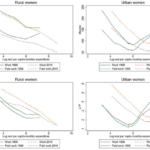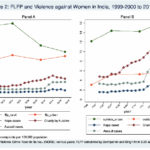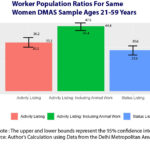Measuring Work: Comparing Employment-Unemployment Surveys with Time Use Surveys
In a simple economic framework households supply labor and businesses absorb them (the circular flow). Thus we can measure labor either from households or from business establishments. Ideally the two sides should give the same numbers, but that never happens in practice. The boundaries of business establishments are blurred, and defy clear identification to have a well-defined frame for surveys. Moreover, household members could be part of more than one establishment. Therefore, household surveys are considered a better option for measuring employment. The National Sample Surveys on Employment –Unemployment (EUS) are household surveys.
In the beginning, the idea was to consider gainful occupation of people that remunerated them directly or indirectly in cash or kind leading to counting of persons reporting any profession, occupation or trade as gainfully employed. In effect this led to identifying people with attachment to an occupation as employed with no clear reference period. The labor force frame work where performing some work “for pay or profit” during a short reference period was recommended by the International Labor Organisation(ILO) in the 1960s and got adopted worldwide. The present survey framework links work with the performance of an economic activity.
The concept of work is also linked to the production boundary specified in the System of National Accounts (SNA). Broadly the activities that are included in the SNA boundary are paid employment, self-employment in market enterprises, subsistence work, volunteer work in market or non-market enterprises, and volunteer work in households that produces goods for final use. Two productive activities outside the SNA are volunteer work in households that produces services for own final use and unpaid household services work (domestic work). In the EUS, the term ‘economic activity’ includes all activities that result in production of goods and services forexchange, the ‘market activities’. Of the non-market activities, it includes activities relating to the primary sector which result in production of primary goods (including free collection of uncultivated crops, forestry, firewood, hunting, fishing, mining, quarrying, etc)and the activities relating to the own-account production of fixed assets. Thus, the EUS coverage of production boundary is slightly more restrictive compared to the SNA production boundary.
The measurement of employment, thus involved both the activity performed within the SNA production boundary as well as the length of time it was performed within the reference period. According to the concepts adopted in 19thInternational Conference of Labor Statisticians (ICLS) in 2013, “work” comprises any activity performed to produce goods or to provide services for use by others, or for own use. Further, work is defined irrespective of its formal or informal character or the legality of the activity and excludes activities that do not involve producing goods or services (e.g., begging and stealing), self-care (e.g., personal grooming and hygiene) and activities that cannot be performed by another person on one’s own behalf (e.g., sleeping, learning and activities for own recreation).
The concepts adopted in the current EUS framework define work as performance of any economic activity within the SNA production boundary, with minor exceptions like production of services for own use with the time spent on the activity as one hour during the reference week/day or major part of the year for usual activity. Thus, the underlying concept of what constitute work are identical in our current framework (i.e. NSS EUS) and the 19th ICLS of the ILO.
The employed in EUS are those working as self-employed, casual work and regular wage/salaried, as also those who are temporarily away from work but were attached to work (generally a negligible number). Persons who are engaged in productive activities, though not covered in the general production boundary, are separately identified to understand women’s contribution to household economy. The conceptual framework used in current Periodic Labor Force Surveys (PLFS) is same as the one used in EUS.
In actual practice individuals spend only some part of the day in work; occasionally in more than one type of work in a day (Only in 8.5 percent cases workers reported two different work activities in a day)[1].To ensure that the identification of an individual as a worker is unambiguous and mutually exclusive, the labor force survey framework use a priority cum major time criteria to assign a status (i.e., employed, unemployed or out of labor force) to a respondent. In this, the status of employed gets priority over the other two and the unemployed status gets priority over the out of labor force status. Some more explanation about the concept of priority here would be useful, maybe with an example.
Where a person is engaged in more than one work activities, the specific work activity is assigned using a major time criterion. NSSO also uses a concept of usual status where the reference period is the year preceding the date of survey. The usual status has two components, namely usual principal and usual subsidiary status to indicate if the work status was pursued in a principal capacity or only in a subsidiary capacity for some time in the year. While for men, subsidiary employment is negligible in the overall employment, it is as high as 25 percent for women. (NSSO employment survey reports) The globally accepted criteria is that of a person having worked at least for an hour during the reference period of a week or day to be counted as a worker.
Time Use Surveys
The primary objective of a Time Use Survey (TUS) is to measure the extent of participation of respondents in paid and unpaid activities and the time spent in each activity. This is achieved by classifying all activities according to a well-defined set of activities, viz. International Classification of Activities for Time Use Statistics (ICATUS). At the broadest level, the activities are grouped in to 9 Divisions as Employment and related activities, Production of goods for own final use, Unpaid domestic services for household members, Unpaid caregiving services for household members, Unpaid volunteer, trainee and other unpaid work, Learning, Socializing and communication, community participation and religious practice, Culture, leisure, mass-media and sports practices, Self-care and maintenance. The detailed classification also helps in grouping activities into SNA production, non-SNA production and other residual activities[2].In the recent TUS 2019, information on activity particulars were collected with a reference period of 24 hours starting from 4:00AM on the day before the date of interview. Besides the time spent in each specific activity with a 30 minutes slot for each activity, TUS also recorded multiple activities during the time slot as well as if the activities were done simultaneously.
A summary of the participation and average time spent per day considering all the activities reported in the time slot is given in Table 1 separately for men and women. A lot of stories are concealed by the manner of aggregation done to produce these numbers like the time distribution of the activities during the day. The percentage of women workers derived through EUS looks close to the women reporting participation in employment related activities. Over 90 percent of women also spent on an average over five hours in household services that are outside the production boundary in conventional employment statistics. The time spent in employment and related activities that generally corresponds to work by women is almost two hours less than that for men, showing the blurred edges of work and non-work division of time in the case of women.
Comparing work participation estimates in EUS and TUS 2019
A major issue with the conventional EUS has been its purported under reporting of women’s work participation. The EUS considers all activities involving production of goods and services for market, production of primary goods for own consumption and the production of own account assets as work. EUS measures employment in three different ways. Apart from the usual status employment, it captures the standard measure of employment using the weekly status where working for at least one hour in any day of the week qualify persons to be counted as a workers. The third measure is the daily status obtained by aggregating the daily activities of the seven days of the week to produce an estimate percentage of person-days employed.
ICATUScodes 11 to 18 (Employment related activities) roughly corresponds to the work activities used in EUS. Besides this, parts of activity codes 21 to 25 (Production of goods for own final use) would also be included where these relate to the primary sector. The main difference in a straight forward comparison arises due to the absence of an inbuilt classifying criteria in TUS to identify a worker. It provides a list of activities performed in each of the time slot and corresponding time spent during the 24 hours of the reference day. Activity classification in table is therefore not mutually exclusive. In the Table 2, I have put together estimates from TUS 2019 and the PLFS 2018-19 that has six months overlapping survey period with TUS. For comparability with TUS, all figures are reported for population 6 years and above.
 Table 2
Table 2
*these figures are computed form the micro data of the PLFS 2018-19
**some of these activities in the primary sector would be included in work in EUS provided it meets the time criteria
The percentage of usually employed men in the TUS is found to be much higher compared to the PLFS estimate, though for women these two are close enough. There is no simple explanation for this divergence, but this does not have any implication for TUS statistics. The PLFS estimate of “usually employed in the principal status” which is a more robust workforce estimate and the percentage of persons participating in employment related activities in TUS are close. An estimate compiled from the status recorded for the day before the survey day in PLFS, which is actually more comparable with the TUS with the same reference day, is also very similar. It would therefore appear that the work participation rates captured in EUS is similar to the estimates based on participation in employment related activities recorded in TUS.
The last two rows are relevant for analysing TUS as a better reflection of women’s work, in particular for rural women. Their participation in activities falling within the SNA production boundary stands up, substantially if one also includes production of goods for own final use. Analysis of the TUS unit level data with appropriate time criteria and choice of activities can improve these estimates more meaningfully.
The report from the National Statistical Office is somewhat sketchy on the operational aspects, which is very important considering the research questions expected to be answered by TUS. The Tables provided in the report should be treated as the starting point in exploring not just the distribution of time among activities but also the pattern of activities during the day. This will be useful to construct improved definitions of women’s work as different from the conventional EUS.
The availability of the micro-data from the TUS to the researchers is expected to reveal many interesting dimensions of women’s activities especially when one uses more appropriate age groupings than done in the survey report. Correlating time use with household amenities and other household characteristics is also important to reveal wider dimensions of time use. Unfortunately, the omission of children below 6 years of age from the household list is a drawback to understand time spent in activities like childcare.
Endnotes:
[1] 68th round of NSS conducted in 2009-10
[2] Time Use in India – 2019, National Statistical Office, Ministry of Statistics and Programme Implementation, 2020
If you wish to republish this article or use an extract or chart, please read CEDA’s republishing guidelines.



 Table 1
Table 1



